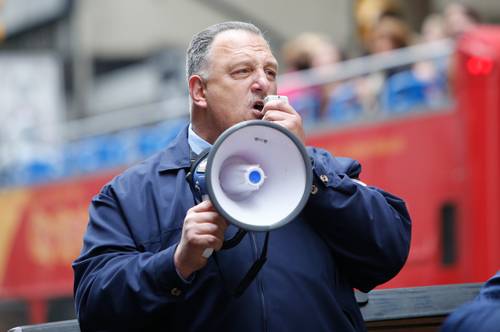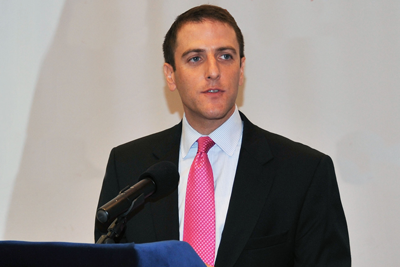In February, President Donald Trump — in the words of his press secretary — took “the shackles off” the U.S. Immigration and Customs Enforcement (ICE). A few weeks earlier, the president signed a pair of executive orders aimed at ramping up immigration enforcement and cracking down on so-called sanctuary cities.
For industries traditionally populated by immigrants, like construction, the policies could have significant implications. The uncertainty surrounding how these orders will play out nationally and even in cities like New York and Los Angeles —where the elected officials have emphatically spoken out against such enforcement — has some workers and advocates concerned about the industry’s future. At the minimum, the policies have put workers on edge and potentially invite abuse in an industry already plagued by safety issues and allegations of exploitation.
“Everything I’ve heard from the Trump administration, seems to create an enormous amount of disruption and panic,” said David Kallick, director of the Immigration Research Initiative at the Fiscal Policy Institute. “It seems like we’re in for a series of high-profile raids on workplaces to try to find undocumented immigrants.”
By the numbers
It’s impossible to definitively quantify the number of undocumented construction workers in the U.S., but the data available paints a picture of an industry that heavily relies on immigrants, both authorized and otherwise.
A report released by City Comptroller Scott Stringer in January showed that 74 percent of the city’s construction workforce is foreign born. A U.S. Census Bureau’s American Community Survey found that 253,984 men and women work in the construction industry in New York City. Of those who answered the survey question (155,476), 60 percent said they are not U.S. citizens (that does not necessarily mean they’re not authorized to work in New York; that number is not known). New York State is home to roughly 4.5 million immigrants, of which at least 1.9 million are not citizens, according to the Census survey. A bulk of these individuals — 3.3 million — live in the city and hail from more than 150 countries, according to the comptroller’s report. Immigrants make up nearly 40 percent of the city’s total population.

Gary Labarbera (Credit: Getty Images)
Nationwide, roughly 15 percent of all construction workers are undocumented, according to a 2014 Pew Research Center survey. In California, undocumented workers comprise 21 percent of the construction workforce, according to a report by the California Immigration Policy Center. Workers in other industries, like hospitality, are concerned about crackdowns. In Miami, where the mayor has said he will comply with Trump’s enforcement of immigration policies, Pew estimates 450,000 immigrants are undocumented.
Hector Chichoni, a partner at the law firm Duane Morris and chair of its immigration practice in Miami, estimates that at least 30 percent of the construction workers in South Florida are immigrants. Trump’s new immigration policies will undoubtedly create “more hassles” for South Florida’s construction industry, he said.
“You will be policing and creating more penalties in an environment of fear when you have to foster an environment of growth,” he said.
Danger looms
The looming threat of ICE agents descending on a worksite — even if unlikely — Could Drive workers “further underground,” Kallick said. Construction workers could be less willing to speak out against unsafe or otherwise unfair work conditions and might be more inclined to pick up and leave a job at even the smallest sign of danger.
“They are fearful that ICE will just sweep in,” George Miranda, president of Teamsters Joint Council 16, which represents a range of industries in New York, told The Real Deal. “They are just apprehensive. You are probably going to have a lot of people leave jobs and projects haphazardly.”
Amanda Saviss, a spokesperson for Los Angeles-based developer Raymond Saviss (her father), said that they haven’t really considered how Trump’s policies could impact their business. For now, she’s not too worried.
“I don’t think he’d be able to completely wipe out all of the illegal immigration construction workforce,” she said. Still, it’s something that the small company may need to consider down the road.
“I do know that he’s capable of having people removed or deported, and I do think that will increase construction prices by a very small fraction,” she said. “It’s something that we should consider in the future.”
In New York, the issue is heavily tied to the ongoing debate over the safety of union versus nonunion construction sites. Union advocates have long argued that worksites run by nonunion shops are inherently less safe. Gary LaBarbera, president of the Building & Construction Trades Council, has said that a majority of the 30 construction-related deaths in the city in the past two years occurred on nonunion sites. When asked about Trump’s policies, and whether they will impact the industry, LaBarbera said it was too premature to tell.
“This is now being highly contested. We have to see where everything lands,” LaBarbera said.
Seth Pinsky [TRDataCustom], executive vice president of RXR Realty, argued that construction, like most industries in the city, will be negatively impacted by Trump’s policies. Even contractors who hire predominately documented workers might feel the secondary crush from other companies — like building material suppliers — that disproportionately hire immigrants.

Seth Pinsky (Credit: Getty Images)
“Immigrants generally are a very important part of the mix of ingredients that led to the rebirth of New York City in the last 30 or 40 years,” he said. “Anything that chills the likelihood of people coming to New York from around the world is going to have a significant negative impact on every industry.”
He noted that it’s unclear how big the “gap is between what [Trump] says and what he does.”
Francis Greenburger, CEO of Time Equities, said that he’s more concerned that immigration crackdowns will discourage international buyers from investing in major markets like New York, Miami and the west coast. He also echoed Pinsky’s concern that Trump’s policies will deal a blow to the city’s economy.
“If we destroy the economic engine, then we’ll be losing massive numbers of jobs, including many documented jobs,” he said.
The New York Committee for Occupational Safety and Health released a report earlier this year that found that not only are nonunion sites less safe, but Latinos are “disproportionately impacted by unsafe working conditions.” The report cited the 2015 death of Carlos Moncayo, a 22-year-old undocumented worker from Ecuador who was killed at a site in the Meatpacking District. The nonunion construction company working on the site, Harco Construction, was convicted of criminally negligent homicide and manslaughter last year, though the firm only had to pay a $10,000 fine.
Nadia Marin-Molina, associate director at NYCOSH, noted that while Trump plans to hire 10,000 new ICE agents, OSHA only has 2,200 inspectors for workplaces nationwide. She said that the executive orders will intensify workers’ distrust of government.
“The problem is, with all of the attacks on immigrants that Donald Trump has put out through the Executive Order and his rhetoric, workers are not going to feel safe confronting their employers,” she said. “We’ve already heard reports of workers who say that employers have said, ‘Donald Trump is going to get all of you anyway,’ Employers know that they can use this as an intimidation technique.”
Araceli Campos, executive director of the L.A.-based Miguel Contreras Foundation, echoed this sentiment, saying that employees may fear reporting safety issues or fighting for their wages for fear of retaliation in the form of deportation.
“A lot of employers, who are unscrupulous and deny their workers fair wages and safe conditions are the same employers who would call ICE on their employees when they demand their safety and fair wages and those types of things,” she said.
Ina Cordle contributed reporting.
